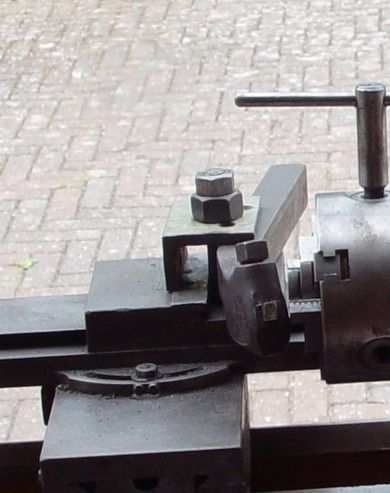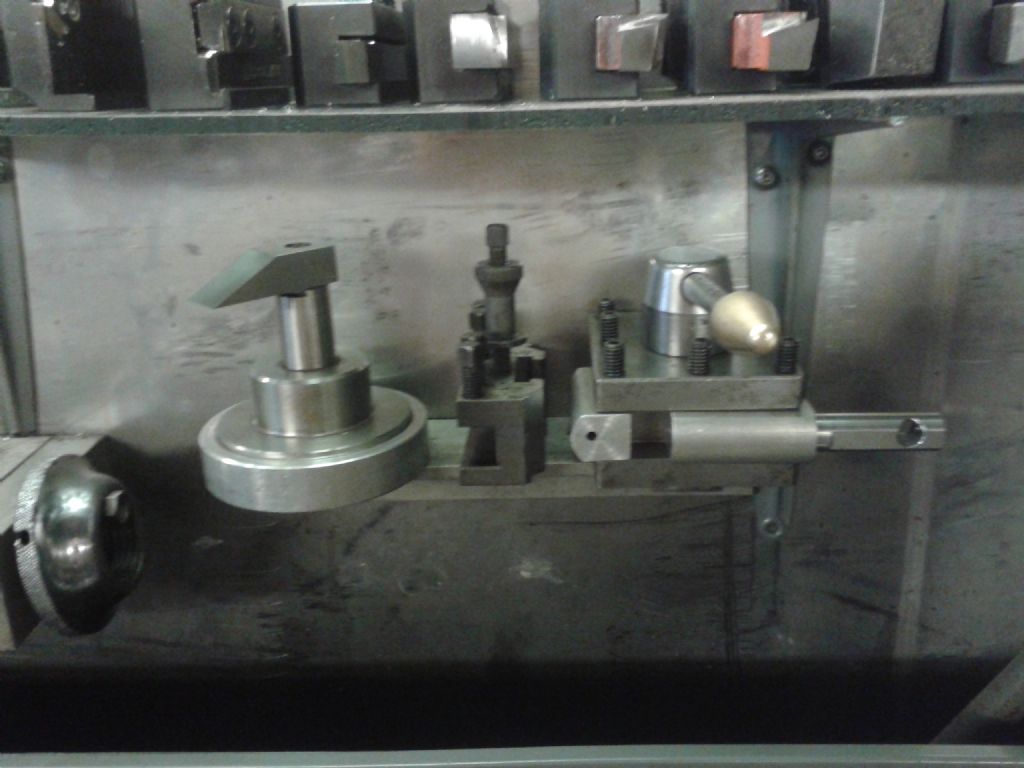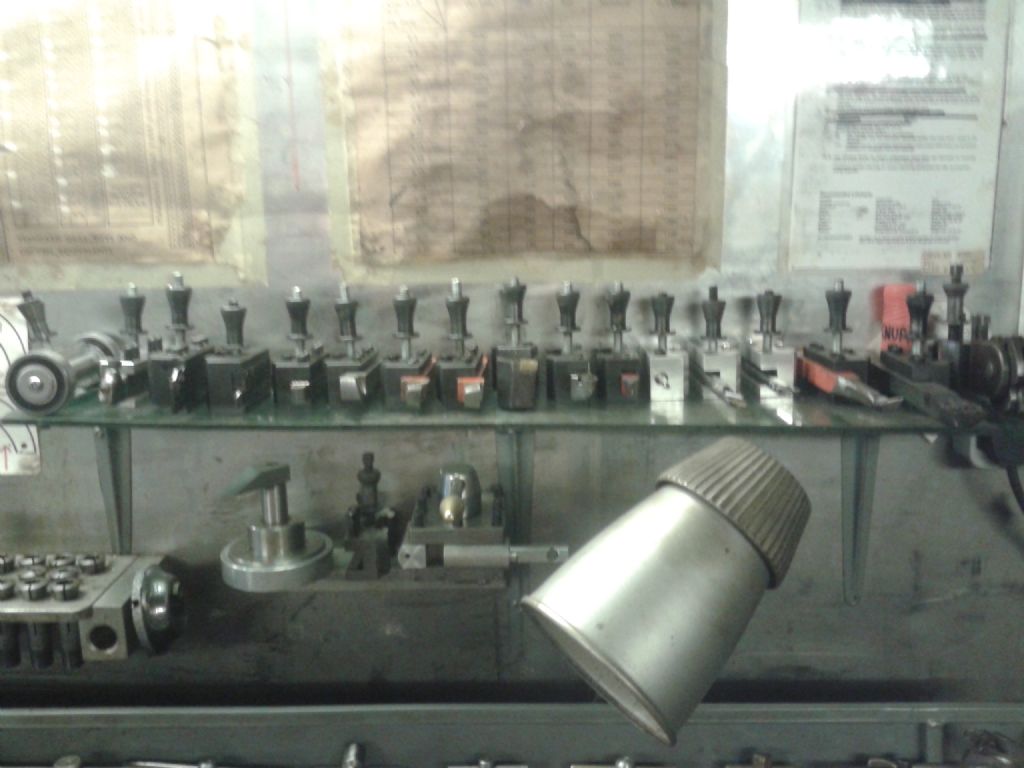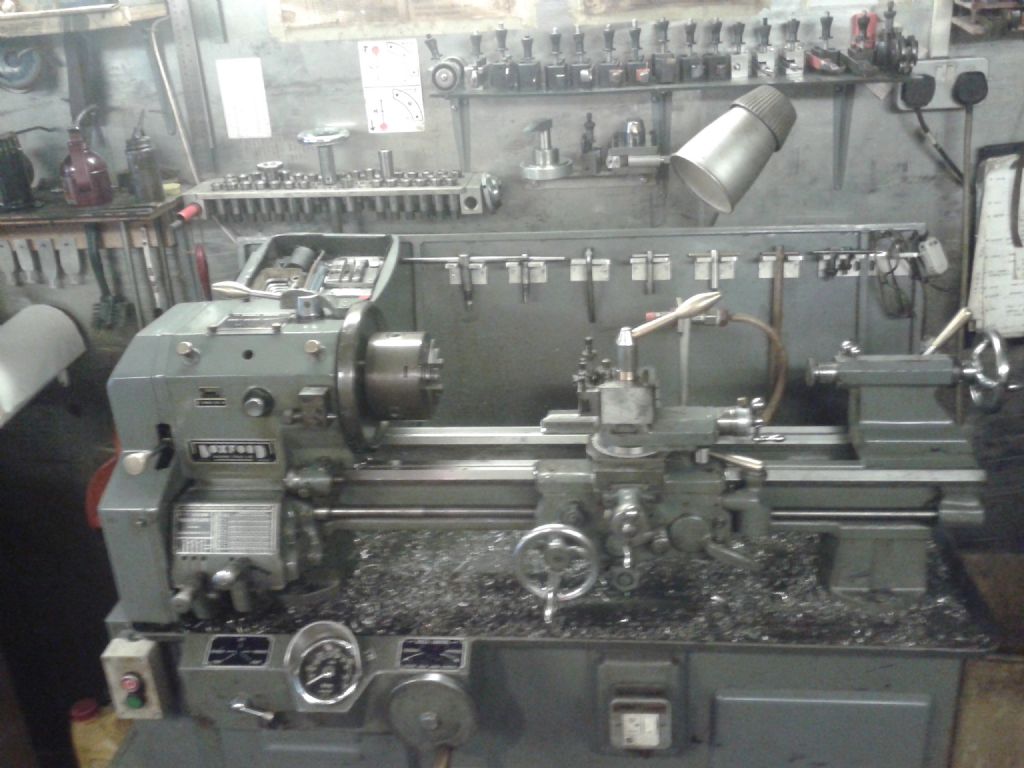Quick change tool post
Metal lathe
| Matt Reid | 27/04/2020 16:43:19 |
| 7 forum posts | Hi first post need help in finding a quick change tool post for a dalton lathe which has lantern post if anyone can help with information please get in touch thanks great site |
| not done it yet | 28/04/2020 07:28:33 |
| 7517 forum posts 20 photos | Rather depends on centre height/swing and clearance (to centre height) over the slide. It would help, to get some recommendation, if you were to provide more detail. At a guess, the same as for the average myford. But armed with those details, suppliers would easily make a recommendation from their range of offerings. |
| Michael Gilligan | 28/04/2020 08:05:24 |
23121 forum posts 1360 photos | Posted by not done it yet on 28/04/2020 07:28:33:
[…] At a guess, the same as for the average myford. […] . Too help avoid speculation, Matt ... Have a look through these pages: **LINK** http://www.lathes.co.uk/dalton/index.html Hopefully you can then tell us which model of Dalton you have.
MichaelG. |
| Matt Reid | 28/04/2020 09:16:31 |
| 7 forum posts | Thanks for all your help looking at the link I can confirm it is a b4 dalton I am new to lathes with this information can you recommend quick change tool post would fit even a used one thanks again |
| Bazyle | 28/04/2020 10:03:37 |
6956 forum posts 229 photos | Welcome to the forum. If in the UK the Dalton is rather rare I think. |
| ega | 28/04/2020 10:13:00 |
| 2805 forum posts 219 photos | Posted by Bazyle on 28/04/2020 10:03:37:
and have built in tool height adjustment that holds between changes Please explain how this works. I thought that when the toolholder is released the saucer shaped washer is free to move thus losing the height setting? |
| Vic | 28/04/2020 10:30:28 |
| 3453 forum posts 23 photos | I use a four way tool post with a Tangential tool which has its own height adjustment. I also use insert tooling either with the tool trimmed on the mill or a spacer permanently bonded to the underside so they’re always on centre. |
| Matt Reid | 28/04/2020 10:36:49 |
| 7 forum posts | I want a easy set up would need to keep trying to set wedge it's not easy and can't sharpen hss that's why I would like a descent cheap holder |
| Howard Lewis | 28/04/2020 10:51:37 |
| 7227 forum posts 21 photos | Like Vic, I am an enthusiast for a four way toolpost and Tangential Turning Tool. I lack the space to store the eight or more QCP toolholders, that are likely to be needed, and time is rarely of the essence for hobby work, rather than industry or a jobbing shop. I abhor boat tool holders, because as the height is adjusted to centre, the rake changes. With the Tangential tool, it is set to centre height without changing any other setting. It is also a doddle to sharpen, since there is only one face to grind. Well worth making a Centre Height Gauge to make setting easier. A four way means that you can certainly have three tools ready for use, may be even possibly four I have four way back toolpost on my lathe, as well, so have a choice of six tools always available. Parting, front and back chamfer in the back post. Rougher, Tangential, and Boring tool in the front. The Boring bar comes out for knurling or (rarely) ball turning. If you want, you can make a fourway toolpost in your lathe, either from one solid piece of metal, or from laminations of slightly thinner steel. A Centre lathe is a MOST useful machine!. If you want a QCP go for it, but I do remember an article in MEW where someone extolling his QCP said that tool changing was no quicker than with a four way toolpost Sorry if this causes any confusion, but it is an alternative. Howard. |
| Dave Halford | 28/04/2020 11:13:49 |
| 2536 forum posts 24 photos | Hi Matt, Welcome to the world of ancient lathes. I have a T&LM which came with the lantern post, which I converted to flat mount with a bigger Armstrong type 1" holder. Bazyle's point holds if you mount it like I did. It's simply a lump of angle iron cut slightly higher than the holder and it's best to use a flat plate in the tee slot that fills it completely to protect the cast slot from over tightening. You need to pick a holder size that works for your lathe and pull the HSS out of the holder till it matches your centre height. The chuck key is in a terrible place for a working lathe, this was part of a pic for selling it and put there only to prove there was one present Edited By Dave Halford on 28/04/2020 11:17:29 |
| Clive Foster | 28/04/2020 12:18:09 |
| 3630 forum posts 128 photos | Matt The lathe type Armstrong toolholders set the tool bit pointing upwards at a shallow angle. (Flat ones are for shapers.) Simply sliding the tool in or out as appropriate allows you to adjust the tip height. Although limited this inherent adjustability is quite enough to let you replace the boat and saucer shape washer unit with a simple plain flat washer thick enough to bring the tip close to centre height. Final positioning being by sliding the tool. Many folk have simply dumped the boat and flipped the saucer washer over to give a flat surface for the Amstrong to sit on. General opinion is that this works better with an extra spacer as without it the tool bit projection becomes longer than desirable. Something around 1/8" to 3/16" thick is commonly suggested by American users of lathes similarly sized to yours. But it depends on what breed your "Armstrong" holder is as shank depth and height of tool above the base does vary between makes. Same plain washer trick works just fine for carbide insert tooling except now you have to match the spacer to the particular tool holder so the cutting tip is at centre height. No great issue with the "flip the saucer washer" trick as you need an extra spacer anyway. Except for parting tools its generally possible to choose a set of toolholders that put the cutting tip at the same height above the base for all the different shapes an angles so one spacer will do for all. A parting tool is best held in its own dedicated block to maximise rigidity. As for sharpening HSS tooling the uptilt angle of the bit in the Armstrong holder basically provides top rake so only the two sides of the tool need to be sharpened. Probably the simplest way for a neophyte to get angles using a conventional grinder is to arrange a raised toolrest so the curve of the wheel naturally puts a satisfactory angle on. There have been couple of recent articles in MEW covering this method. Hopefully someone who actually uses it will chime in with practical assistance. Despite the pundits and textbooks the angles aren't critical for ordinary home shop users. Really sharp beats "book correct angles" any day. A flat top is perfectly satsfactory at home shop cutting depths. For brass the Armstrong uptilt angle will be too great, but its easy to grind top at a flat angle to compensate. A potential issue when using older lathes designed for lantern or block toolposts with QCTP systems is overhang. Of necessity the tool in a QCTP must be well off to one side of the stout central post which almost invariably gives significant overhang relative to the cross and top slide ways on older, small, machines. Not being designed for this an older machine often doesn't cope well with the offset loads. Inevitable wear over many years doesn't help. Lantern or block type holders put the tool rather more central on the topslide giving more equalised loads. which would seem a more desirable state of affairs. Entirely adequate block style toolposts can be made by screwing and gluing together stock metal sections. I'd go for a two slot system. Perhaps 3/8" thick steel flat bar of suitable width for the bottom, thicker is good if the toolholder doesn't end up too high. 1/2" or, better, 5/8" for the top and a lump of alloy bar in the middle a little over two toolholder widths slimmer with perhaps 1/4" clearance above the toolholder when its suitably spaced up. Alloy is easier to tap than steel and plenty strong enough.. M6 countersunk screws to hold it together, M6 capheads to hold the tool in. Four way posts of that style worked for me with my SouthBend machines many years ago. Four or five loaded up with tools and ready to go made an adequate poor boys substitute for a proper QC set up. But I only ever used two slots. Clive Edited By Clive Foster on 28/04/2020 12:20:41 |
| Howard Lewis | 28/04/2020 14:36:53 |
| 7227 forum posts 21 photos | Carbide was developed with the object of maximising production rates, using high cutting speeds on rigid industrial machines. They work on hobby machines but probably not as effectively as they were originally intended to be. The older the machine, the less likely it is to be really suitable, for such tooling. Also, Carbide is more easily chipped than HSS, and more costly.. The principle on which it cuts is different from HSS, and may be unsuitable for some materials. It does cut hardened steel beautifully! So horses for courses. For the cost of one Carbide tip you can buy a HSS toolbit which can be reground many times, and so outlast the tip.by a long way. With a simple bench grinder, you can sharpen HSS tools, (and twist drills if you are careful ), and shape it to the form that you require, such as for chamfering or radiusing, and eventually, even screw cutting.. Get one, because you will need it to sharpen tools whatever form of toolpost you use. If you are unsure of how to grind a tool, buy a book such as L H Sparey's "The Amateur's Lathe", Ian Bradley's "The Amateur's Workshop" or Tubal Cain's "Model Engineers Handbook". They will all be good reference books, containing information that you will find useful at some time. The short 1/4" toolbit in my Tangential Turning Tool is not yet worn out, despite all the use and abuse that it gets as the main cutting tool on the lathe, over the last three or so years. When I bought my used Myford ML7 back in about 1980, I was given a HSS parting tool. It is still only about half length, so a long way from being worn beyond further use. Learning how to grind a HSS tool will be a skill that will never cease to be be useful. Howard |
| Matt Reid | 29/04/2020 13:20:13 |
| 7 forum posts | Guys thanks for all reply think I will try get a cheapish qrtp so problem now is how to measure up for tool post if poss could a picture be put up as I am new to lathes you have gave me a lot to think about on subject as I can't sharpen hss if I get new tool post it might give me the chance to try other cutters again thanks |
| Bazyle | 29/04/2020 13:44:32 |
6956 forum posts 229 photos | Ok since you are determined lets get down to business on QCTPs. There are 3 main types for hobbyists.and lots of home made and less common types. All varieties have a number of different size designations depending on the manufacturer. Measure the distance between the top of your topslide and the centre line of your spindle. This is the important bit not the size of your lathe in what it can turn (as in its a 4 in centre height lathe or a 10 in swing lathe). Let us know and we can see who has the same size. Edit: Beware cheap toolposts that are actually aluminium. Make sure you are getting steel. It is a big con trick in the last few years. Edited By Bazyle on 29/04/2020 13:47:31 |
| Former Member | 29/04/2020 14:05:30 |
[This posting has been removed] | |
| Bazyle | 29/04/2020 15:55:10 |
6956 forum posts 229 photos | I deliberately left out the multifix which is far too expensive for a hobbyist. |
| Former Member | 29/04/2020 16:10:55 |
[This posting has been removed] | |
| thaiguzzi | 29/04/2020 16:51:05 |
704 forum posts 131 photos | Clive as usual is right on the money. Howard's comment on an article about a 4 way being as quick to change a tool as a QCTP. Puleeze. i mean its not a race but how do you beat 5 seconds? If that. I have a Dickson, and 19 toolholders,and have used Dicksons for 30 odd years, but TBH, all the QCTP these days for home shop use are pretty much of a muchness. I also made myself a Lantern a couple of years ago, flat washer - no boat, and it has become a usefull little tool, gets in tight spaces and can shift metal. I also have the original, genuine, ratcheting every 45 degrees 4 way, and is comfortably my least favourite holder, always relegated to last choice and "do i really have to"? So, plenty of different, healthy opinions, as per usual. IMHO, i'd get used to your lathe first, buy some HSS, use your lantern WITHOUT the boat, and spend the QCTP money on a decent 6-8" bench grinder. The choice is yours.
|
| clogs | 29/04/2020 17:20:35 |
| 630 forum posts 12 photos | thaiguzzi....... rather like ur degree circle.....tool post..... as I'm getting olde this would make a good add on......... did u make it......? ta |
| Howard Lewis | 29/04/2020 17:30:47 |
| 7227 forum posts 21 photos | As I've said before, as a hobby, time is not of the essence. No one is standing behind us with a stop watch! Absolute deadlines rarely trouble us. Have to say that I was surprised to read the comparison between the two types. Fully agree with Thaiguzzi about becoming familiar with the machine, tools, (and grinding thereof ) and machining before making things too complicated. The Centre Height Gauge, is an example of the sort of device that would be a good investment of time and material, and as as a means of gaining experience. If you are unsure of how to go about making one, I am sure that there would be plenty of folk who would explain how they went about making the one that they use. Howard |
Please login to post a reply.
Want the latest issue of Model Engineer or Model Engineers' Workshop? Use our magazine locator links to find your nearest stockist!
Sign up to our newsletter and get a free digital issue.
You can unsubscribe at anytime. View our privacy policy at www.mortons.co.uk/privacy
- hemingway ball turner
04/07/2025 14:40:26 - *Oct 2023: FORUM MIGRATION TIMELINE*
05/10/2023 07:57:11 - Making ER11 collet chuck
05/10/2023 07:56:24 - What did you do today? 2023
05/10/2023 07:25:01 - Orrery
05/10/2023 06:00:41 - Wera hand-tools
05/10/2023 05:47:07 - New member
05/10/2023 04:40:11 - Problems with external pot on at1 vfd
05/10/2023 00:06:32 - Drain plug
04/10/2023 23:36:17 - digi phase converter for 10 machines.....
04/10/2023 23:13:48 - More Latest Posts...
- View All Topics
- Reeves** - Rebuilt Royal Scot by Martin Evans
by John Broughton
£300.00 - BRITANNIA 5" GAUGE James Perrier
by Jon Seabright 1
£2,500.00 - Drill Grinder - for restoration
by Nigel Graham 2
£0.00 - WARCO WM18 MILLING MACHINE
by Alex Chudley
£1,200.00 - MYFORD SUPER 7 LATHE
by Alex Chudley
£2,000.00 - More "For Sale" Ads...
- D1-3 backplate
by Michael Horley
Price Not Specified - fixed steady for a Colchester bantam mark1 800
by George Jervis
Price Not Specified - lbsc pansy
by JACK SIDEBOTHAM
Price Not Specified - Pratt Burnerd multifit chuck key.
by Tim Riome
Price Not Specified - BANDSAW BLADE WELDER
by HUGH
Price Not Specified - More "Wanted" Ads...
Do you want to contact the Model Engineer and Model Engineers' Workshop team?
You can contact us by phone, mail or email about the magazines including becoming a contributor, submitting reader's letters or making queries about articles. You can also get in touch about this website, advertising or other general issues.
Click THIS LINK for full contact details.
For subscription issues please see THIS LINK.
Model Engineer Magazine
- Percival Marshall
- M.E. History
- LittleLEC
- M.E. Clock
ME Workshop
- An Adcock
- & Shipley
- Horizontal
- Mill
Subscribe Now
- Great savings
- Delivered to your door
Pre-order your copy!
- Delivered to your doorstep!
- Free UK delivery!
















 Register
Register Log-in
Log-in


